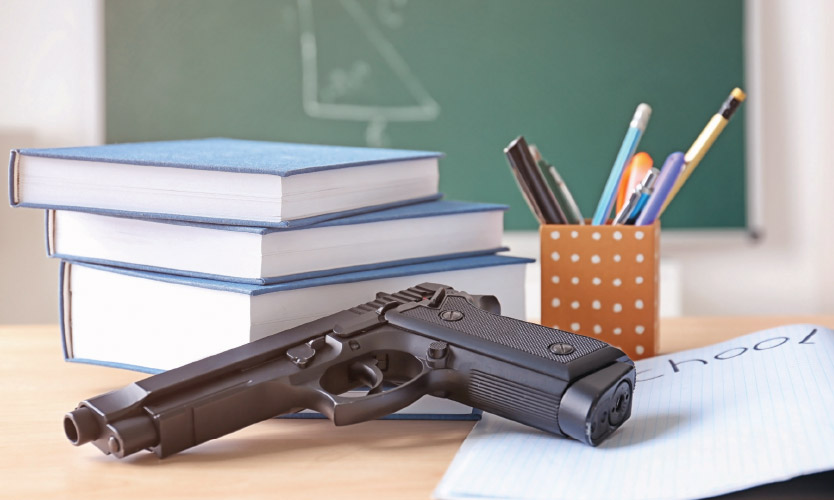As more states permit teachers to carry concealed guns in the classroom, experts say safety training and awareness of potential liabilities should be at the forefront of any school initiative to arm educators.
If staff are injured in an incident involving a teacher using a gun, though, workers compensation benefits would likely be paid, they say.
Thirty-two states allow teachers and school staff to carry firearms as part of efforts to thwart attacks in schools, according to the United States Concealed Carry Association, a gun advocacy and training organization.
Tennessee in April became the latest state to approve armed teachers. Ohio passed a similar measure in 2022.
Approval processes and training requirements vary by state. Some states leave it to the discretion of law enforcement authorities and school districts, and some mandate firearms handling and proficiency training.
Tennessee S.B. 1325, which requires local law enforcement approval for teachers and staff members to carry guns, doesn’t have specific safety protocols built into it. However, the law does say guns are prohibited in certain areas of schools, such as gyms and auditoriums, and cannot be carried during school-sponsored events.
The law also offers liability immunity for local law enforcement agencies — which must sign off on teacher carry — from claims for monetary damages that arise “solely from, or that are related to, a faculty or staff member’s use of, or failure to use, a handgun.”
The measure is similar to laws in other states, but controversies remain over the need for such laws, as school districts weigh efforts to better protect students against the potential dangers associated with guns on campus (see related story below).

Safety experts say training is key to avoid gun-related injuries in school districts where teachers can carry concealed weapons.
“I would recommend written procedures, written protocols, group training,” said Sara Gibson, senior risk manager with St. Louis-based Safety National Casualty Corp.
Districts should provide biometric — or fingerprint-activated — gun safes, bulletproof vests, background checks and mental health screenings, and possibly enhanced insurance policies, according to information published online by Bethesda, Maryland-based United Educators, a reciprocal risk retention group that specializes in insuring schools. United Educators declined an interview.
Even with safety protocols in place, incidents can occur, experts say.
In December 2021, San Francisco-based Giffords Law Center said an analysis it conducted found nearly 100 publicly reported incidents of mishandled guns at schools in the prior five-year period, including accidental discharges and leaving guns accessible to students. Most incidents were injury-free, but in one 2020 Florida incident, a security guard accidentally shot a maintenance worker in the eye while showing off a gun.
In another widely reported incident, a reserve police officer in 2018 accidentally discharged his gun in a Seaside, California, high school while teaching a public safety class. Several students were injured by falling debris.
As more states pass laws allowing educators to be armed at school, workers comp attorneys say little is expected to change when it comes to injury compensability.
The question becomes whether the gun is used within the “course and scope of employment,” said Barak Kassutto, a workers comp defense attorney at the Philadelphia law firm Morgan Akins & Jackson PLLC.
A teacher accidentally shot by a teacher permitted to carry, for example, would likely be covered by comp.
If a teacher accidentally shoots another teacher while defending a student or defending the school, workers comp exclusivity could possibly be escaped if gross negligence was involved, said Davis County, Utah-based Curt Oda, a commercial insurance agent, former state legislator and firearms safety instructor.
Gross negligence could be alleged, for example, if a teacher showed his or her firearm to another teacher and accidentally shot that teacher, said Mr. Oda, a former claims adjuster.
In that case the injured teacher could likely “sue the responsible party because it’s not in the act of defense,” he said.
Whether guns in the hands of educators would increase general liability insurance premiums for school districts is hard to say, said Kevin Pollock, vice president-national director of public entity for Safety National.
“There are many factors that we review and analyze on each risk during the underwriting process,” he said.
Proponents of arming teachers say firearms should be allowed in school to deter or stop active shooters; opponents argue adding more guns is a recipe for collateral damage.
“Teachers are trained to be teachers, they’re not trained to be law enforcement,” said Sara Gibson, senior risk manager with St. Louis-based Safety National Casualty Corp.
Supporters of arming teachers, though, say guns in the classroom are the ultimate prevention and risk mitigation tool.
Curt Oda, a Davis County, Utah-based commercial insurance agent, former state legislator and firearms safety instructor, said allowing employees to carry guns to defend students can help bridge the gap between when a violent incident begins and when police arrive.
“If you could close that gap time, the liability risks actually reduce because you’ve taken steps to mitigate and neutralize the threat factor,” Mr. Oda said, noting Utah has allowed guns in schools for three decades.
In Tennessee, the teachers union has come out strongly against the new law permitting educators to carry guns.
“Arming teachers puts both our children’s education and safety in jeopardy,” Tennessee Education Association President Tanya Coats said in a statement.
The union said educators should be focused on teaching and leave security to “trained and certified officers.”
